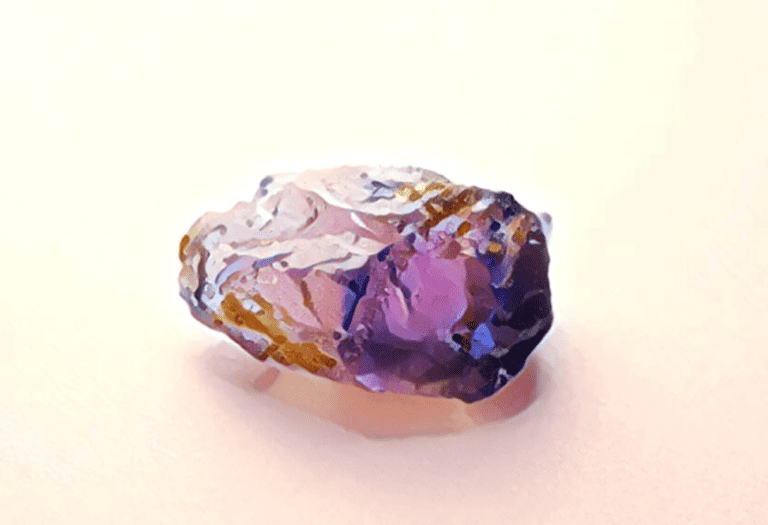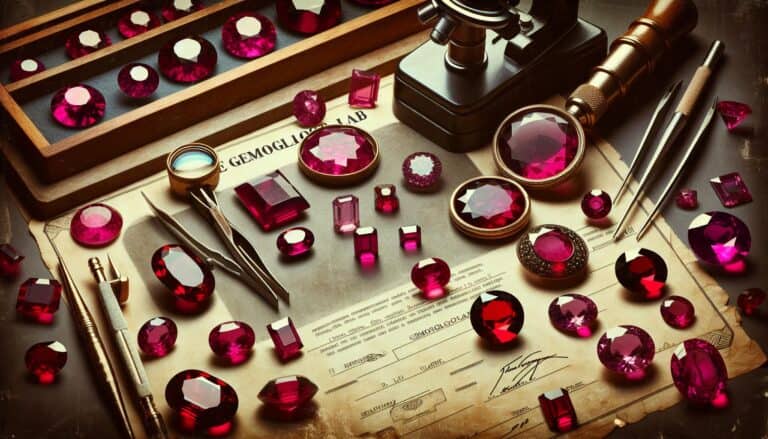Discovering the secrets of gemstones is an adventure, and if you’re on the hunt for phenakite, you’ve got a thrilling challenge ahead.
This rare mineral, often mistaken for quartz or even diamond, has unique characteristics that set it apart.
You’ll need a keen eye and a bit of know-how to identify phenakite correctly. It’s not just about its dazzling beauty, but also understanding its physical and optical properties.
Let’s dive into what makes phenakite a gemologist’s delight and how you can spot this elusive stone.
To identify phenakite, look for its unique characteristics: a hardness of 7.5-8 on the Mohs scale, glass-like luster, and rhombohedral crystal form. It leaves a white streak, is non-magnetic, and exhibits single refraction with a refractive index of 1.650-1.690.
How to Identify Phenakite Through Testing
To ensure that you’re dealing with an authentic piece of phenakite, various tests can be conducted. Here’s how you can distinguish this rare gemstone from its common lookalikes.
Visual Inspection
Start by examining the crystal structure. Phenakite crystals commonly embody a rhombohedral shape, bearing a resemblance to beryl or quartz. Look for a glassy luster – phenakite emits a vitreous glow when light strikes its surface. Inspect for any cleavage lines; phenakite typically has no cleavage, unlike some of its counterparts.
The Streak Test
Perform a streak test to reveal the powder color of the gemstone. Drag your suspected phenakite across an unglazed porcelain plate; phenakite will leave a white streak. This simple step can help differentiate it from other minerals with a colored streak.
Magnet Test
The magnet test involves holding a magnet close to the stone. Phenakite is non-magnetic, so if your stone is attracted to the magnet, it’s a clear sign you’re not dealing with phenakite.
Hardness Test
Use the Mohs scale of hardness for this test. Phenakite has a hardness rating of 7.5 to 8, which is higher than glass but lower than diamond. You can scratch the surface with a steel file – if it scratches easily, it’s possibly not genuine phenakite.
Birefringence Test
Check for double refraction or birefringence by viewing a line through the gemstone. If the line appears doubled, the gem displays birefringence, a feature not present in phenakite, making it a uniaxial crystal.
Checking The Diaphaneity
Examine the gemstone’s transparency or diaphaneity. Phenakite can range from being transparent to translucent. If the stone is opaque, it’s unlikely to be true phenakite.
Single or Double Refraction
Use a polariscope to test for single or double refraction. Position the stone between two polarized filters and rotate it. Phenakite, being single refractive, won’t display any change in color or darkness as you rotate it.
Refractive Index Test
The refractive index (RI) of phenakite ranges between 1.650-1.690. To measure this, you’ll need a refractometer, a tool that can help further confirm if your stone matches the RI of phenakite.
Finding The Specific Gravity
Measure the gemstone’s specific gravity, which for phenakite is about 2.96 to 3.00. This can be done using a hydrostatic balance or heavy liquids with known specific gravities.
Identifying Phenakites in the Field
When searching for phenakite in the field, you’re likely to find them in pegmatite mines or areas with high-grade metamorphic rocks. Keep an eye out for its distinctive crystal formations and glassy luster.
Recognizing Potential Phenakite Rocks
Look for host rocks typically associated with phenakite. These might include granite, mica schist, or dolomitic marble. Familiarizing yourself with these geologic environments will increase your chances of identifying potential phenakite-containing rocks.
Physical Characteristics of Phenakite

When you’re trying to identify phenakite, paying close attention to its physical characteristics can be incredibly telling. First and foremost, phenakite scores a solid 7.5 to 8 on the Mohs hardness scale. This property means it’s quite durable and can scratch glass. A simple scratch test can often help determine if the specimen you have is indeed phenakite or a softer mineral masquerading as such.
Another key characteristic to observe is the color of your sample. Typically, phenakite ranges from colorless to a pale yellow. In rarer instances, you might encounter samples with a light pink or red hue, but these are less common. The stone’s luster is vitreous, meaning it has a glass-like sheen that can assist in distinguishing it from less shiny minerals.
Phenakite’s crystal system is trigonal, which can sometimes be confused with the hexagonal system. Yet, there’s a way to tell them apart: the cross-section of a trigonal crystal typically looks like a rounded triangle. If you’re examining a raw specimen, you may notice distinctive crystal faces that further validate your identification.
Its high melting point, which surpasses that of quartz, adds another layer to your identification process. While not practical in the field, this trait is useful for professionals who can perform controlled heating tests in a lab setting.
Keep in mind that phenakite can associate with certain host rocks such as quartz and chrysoberyl, which can also guide your identification. Paying attention to these physical characteristics will enhance your ability to pinpoint phenakite in various environments.
How Are Phenakite Formed?
When diving into the origins of phenakite, it’s essential to understand that they are formed under high-temperature conditions typically associated with pegmatites and high-grade metamorphic rocks. Pegmatites, which are the igneous rocks known for hosting large crystals like phenakite, form during the final stages of magma crystallization.
As you explore various environments, you’ll find that phenakite can also emerge in mica schists, often found in the company of quartz, chrysoberyl, and topaz. The formation process is not a quick one; it takes millions of years for the perfect conditions to crystallize and create phenakite.
The chemical composition of phenakite is Be2SiO4—beryllium silicate. It’s important to note that beryllium is a rare element, which partly explains the rarity and value of phenakite. High temperatures and pressures, along with beryllium-rich environments, are the recipe for the birth of this mineral.
In specific locales, phenakite is found associated with other gemstone minerals, indicating a diverse mineralogical environment. Knowledge of these associated minerals can provide clues for prospectors. Keep an eye out for emerald and aquamarine, which could signal the nearby presence of phenakite due to their shared affinity for beryllium.
Understanding the formation of phenakite helps not just in identifying it but also appreciates its rare beauty and value. When you’re evaluating a potential phenakite specimen, consider its origins and the geologic journey it’s been on – it can add another layer of appreciation for this crystal.
Preparation for Phenakite Hunting
Before diving into the adventure of hunting phenakite, you’ll want to be well-prepared. Proper preparation not only increases your chances of a successful find but also ensures that your search is both enjoyable and safe. Let’s take a look at what you’ll need.
Gathering the Right Tools
Hunting for phenakite requires specific tools tailored to the job. Ensure you have the following items:
- Geologist hammer or pick: A must-have for extracting crystals from host rocks.
- Streak plate: Useful for performing a streak test to determine the color of the mineral in powdered form.
- Hand lens or magnifying glass: This will help you to closely examine the crystal structure and other physical characteristics.
- Safety goggles: Always protect your eyes from flying rock fragments.
- Durable gloves: Protect your hands while handling sharp rocks and tools.
- Hardness testing kit: Key for testing phenakite’s hardness, which can help differentiate it from other minerals.
- Portable refractometer or polariscope: Essential tools for checking for birefringence and single or double refraction.
- Field guide: To assist with on-the-spot information about phenakite and associated minerals.
Having a backpack to carry these items will keep your hands free while searching.
Safety Considerations
When hunting for minerals like phenakite, safety is paramount. Remember these points:
- Plan your trip: Always let someone know where you’ll be and when you expect to return.
- Wear appropriate attire: Durable boots and long pants will protect against snakes, insects, and sharp objects.
- Bring plenty of water and snacks: Staying hydrated and energized is important, especially in remote locations.
- First aid kit: Be prepared for any minor injuries that may occur while out in the field.
- Stay aware of your surroundings: Watch for potential hazards such as wildlife, cliff edges, and unstable ground.
By keeping these safety considerations in mind, you’re ensuring a more secure phenakite hunting experience. With the right tools and precautions, you’re better equipped to identify and collect phenakite while enjoying the great outdoors. Remember that patience and persistence are key, as phenakite is rare and can be elusive, but with determination and careful preparation, you’ll improve your chances of a rewarding discovery.
Handling and Care of Found Phenakite

Once you’ve identified and collected phenakite on your hunting expeditions, it’s crucial to know how to properly handle and care for these gemstones. Preserving phenakite requires careful cleaning and storage to maintain its brilliance and value.
Cleaning Phenakites
Phenakite can accumulate dirt and residues, which may obscure its natural luster. To clean your stones:
- Use lukewarm water and a soft bristled brush.
- A mild soap can be used, but ensure it’s chemical-free to avoid damaging the stone’s surface.
- Rinse thoroughly with distilled water to prevent residue from tap water.
Avoid using harsh chemicals or ultrasonic cleaners as these can harm the phenakite. After cleaning, pat dry with a soft, lint-free cloth to minimize the risk of scratches.
Storing Phenakites
Proper storage is vital to protect phenakite from damage:
- Keep each stone in a separate soft pouch or a lined jewelry box.
- Place a padded divider between each piece if stored together to prevent scratching.
- Avoid exposing phenakites to extreme temperatures and direct sunlight.
- Consider using desiccants or a dehumidifier in storage areas to control moisture.
By following these steps, you’ll ensure the longevity and beauty of your phenakite collection. With the right care, these gemstones can remain a pristine testament to your successful hunts for years to come.
Conclusion: Confirming Phenakite is Real
Armed with the knowledge from this guide, you’re now well-equipped to identify phenakite with confidence.
Remember, attention to detail is key—whether you’re in the field or examining a potential find at home. By carefully applying the tests and observations discussed, you’ll be able to distinguish this rare mineral from look-alikes. Don’t forget the importance of preparation and safety while hunting for phenakite. And once you’ve confirmed your find, handle it with care to preserve its natural beauty and value.
Happy hunting and here’s to discovering your own stunning piece of phenakite!







